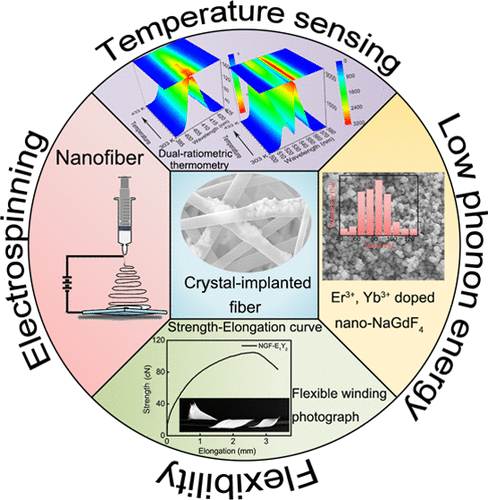当前位置:
X-MOL 学术
›
J. Phys. Chem. C
›
论文详情
Our official English website, www.x-mol.net, welcomes your feedback! (Note: you will need to create a separate account there.)
Cooperatively Responding Thermal Sensing in Erbium(III)-Functionalized NaGdF4/PAN Crystal-Implanted Fiber
The Journal of Physical Chemistry C ( IF 3.7 ) Pub Date : 2021-09-16 , DOI: 10.1021/acs.jpcc.1c05897 Zhe Liu 1 , Yuhang Zhang 2 , Baojiu Chen 2 , Xin Zhao 1 , Edwin Yue Bun Pun 3 , Hai Lin 1, 3
The Journal of Physical Chemistry C ( IF 3.7 ) Pub Date : 2021-09-16 , DOI: 10.1021/acs.jpcc.1c05897 Zhe Liu 1 , Yuhang Zhang 2 , Baojiu Chen 2 , Xin Zhao 1 , Edwin Yue Bun Pun 3 , Hai Lin 1, 3
Affiliation

|
Er3+/Yb3+-doped NaGdF4 crystal-implanted fiber (CIF) is synthesized by the electrospinning technique, which possesses excellent crystal dispersibility, glorious flexibility, and high crystal utilization, realizing temperature sensing in complex and harsh environments. The combination of main and auxiliary sensing endows CIF with self-calibration functionality to realize accurate temperature measurement. Serving as the main thermal response signal for a noninvasive nanothermometer, the absolute and relative sensitivities for effective green emissions are up to 0.446% K–1 at 423 K and 1.018% K–1 at 303 K, respectively. Further, the introduction of a blue emission peak is to participate in the thermal response as an auxiliary indicator to inspect the accuracy of the main thermal sensing data where the absolute and relative sensitivities reach 28.473 and 1.522% K–1 at 313 and 303 K, respectively. The flexible CIF with cooperative response thermometry possesses a broad prospect in nanodomain optical thermometers, which present extraordinary potential in nondestructive temperature monitoring and flexible temperature sensing elements.
中文翻译:

铒 (III) 功能化 NaGdF4/PAN 晶体植入光纤中的协同响应热传感
Er 3+ /Yb 3+掺杂NaGdF 4晶体植入光纤(CIF)采用静电纺丝技术合成,具有优异的晶体分散性、优异的柔韧性和高晶体利用率,可实现复杂恶劣环境下的温度传感。主辅感应相结合,赋予CIF自校准功能,实现精准测温。作为无创纳米温度计的主要热响应信号,有效绿色发射的绝对和相对灵敏度在 423 K 时高达 0.446% K –1和 1.018% K –1分别为 303 K。此外,引入蓝色发射峰是为了作为辅助指标参与热响应,以检查主要热传感数据的准确性,其中绝对和相对灵敏度在 313 和 303 K 处分别达到 28.473 和 1.522% K –1,分别。具有协同响应测温的柔性 CIF 在纳米域光学温度计中具有广阔的前景,在无损温度监测和柔性温度传感元件方面具有非凡的潜力。
更新日期:2021-09-30
中文翻译:

铒 (III) 功能化 NaGdF4/PAN 晶体植入光纤中的协同响应热传感
Er 3+ /Yb 3+掺杂NaGdF 4晶体植入光纤(CIF)采用静电纺丝技术合成,具有优异的晶体分散性、优异的柔韧性和高晶体利用率,可实现复杂恶劣环境下的温度传感。主辅感应相结合,赋予CIF自校准功能,实现精准测温。作为无创纳米温度计的主要热响应信号,有效绿色发射的绝对和相对灵敏度在 423 K 时高达 0.446% K –1和 1.018% K –1分别为 303 K。此外,引入蓝色发射峰是为了作为辅助指标参与热响应,以检查主要热传感数据的准确性,其中绝对和相对灵敏度在 313 和 303 K 处分别达到 28.473 和 1.522% K –1,分别。具有协同响应测温的柔性 CIF 在纳米域光学温度计中具有广阔的前景,在无损温度监测和柔性温度传感元件方面具有非凡的潜力。



























 京公网安备 11010802027423号
京公网安备 11010802027423号